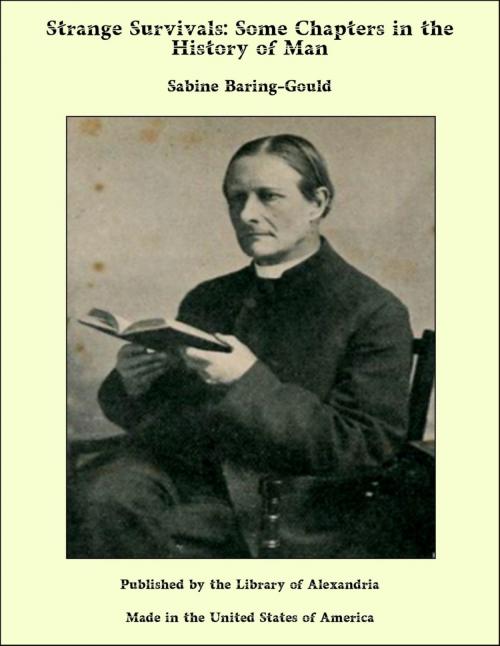Strange Survivals: Some Chapters in the History of Man
Nonfiction, Religion & Spirituality, New Age, History, Fiction & Literature| Author: | Sabine Baring-Gould | ISBN: | 9781465608314 |
| Publisher: | Library of Alexandria | Publication: | March 8, 2015 |
| Imprint: | Language: | English |
| Author: | Sabine Baring-Gould |
| ISBN: | 9781465608314 |
| Publisher: | Library of Alexandria |
| Publication: | March 8, 2015 |
| Imprint: | |
| Language: | English |
All over the north of Europe the greatest aversion is felt to be the first to enter a new building, or to go over a newly erected bridge. If to do this is not everywhere and in all cases thought to entail death, it is considered supremely unlucky. Several German legends are connected with this superstition. The reader, if he has been to Aix-la-Chapelle, has doubtless had the rift in the great door pointed out to him, and has been told how it came there. The devil and the architect made a compact that the first should draw the plans, and the second gain the Kudos; and the devil’s wage was to be that he should receive the first who crossed the threshold of the church when completed. When the building was finished, the architect’s conscience smote him, and he confessed the compact to the bishop. “We’ll do him,” said the prelate; that is to say, he said something to this effect in terms more appropriate to the century in which he lived, and to his high ecclesiastical office. When the procession formed to enter the minster for the consecration, the devil lurked in ambush behind a pillar, and fixed his wicked eye on a fine fat and succulent little chorister as his destined prey. But alas for his hopes! this fat little boy had been given his instructions, and, as he neared the great door, loosed the chain of a wolf and sent it through. The evil one uttered a howl of rage, snatched up the wolf and rushed away, giving the door a kick, as he passed it, that split the solid oak. The castle of Gleichberg, near Rönskild, was erected by the devil in one night. The Baron of Gleichberg was threatened by his foes, and he promised to give the devil his daughter if he erected the castle before cockcrow. The nurse overheard the compact, and, just as the castle was finished, set fire to a stack of corn. The cock, seeing the light, thought morning had come, and crowed before the last stone was added to the walls. The devil in a rage carried off the old baron—and served him right—instead of the maiden. We shall see presently how this story works into our subject. At Frankfort may be seen, on the Sachsenhäuser Bridge, an iron rod with a gilt cock on the top. This is the reason: An architect undertook to build the bridge within a fixed time, but three days before that on which he had contracted to complete it, the bridge was only half finished. In his distress he invoked the devil, who undertook the job if he might receive the first who crossed the bridge. The work was done by the appointed day, and then the architect drove a cock over the bridge. The devil, who had reckoned on getting a human being, was furious; he tore the poor cock in two, and flung it with such violence at the bridge that he knocked two holes in it, which to the present day cannot be closed, for if stones are put in by day they are torn out by night. In memorial of the event, the image of the cock was set up on the bridge.
All over the north of Europe the greatest aversion is felt to be the first to enter a new building, or to go over a newly erected bridge. If to do this is not everywhere and in all cases thought to entail death, it is considered supremely unlucky. Several German legends are connected with this superstition. The reader, if he has been to Aix-la-Chapelle, has doubtless had the rift in the great door pointed out to him, and has been told how it came there. The devil and the architect made a compact that the first should draw the plans, and the second gain the Kudos; and the devil’s wage was to be that he should receive the first who crossed the threshold of the church when completed. When the building was finished, the architect’s conscience smote him, and he confessed the compact to the bishop. “We’ll do him,” said the prelate; that is to say, he said something to this effect in terms more appropriate to the century in which he lived, and to his high ecclesiastical office. When the procession formed to enter the minster for the consecration, the devil lurked in ambush behind a pillar, and fixed his wicked eye on a fine fat and succulent little chorister as his destined prey. But alas for his hopes! this fat little boy had been given his instructions, and, as he neared the great door, loosed the chain of a wolf and sent it through. The evil one uttered a howl of rage, snatched up the wolf and rushed away, giving the door a kick, as he passed it, that split the solid oak. The castle of Gleichberg, near Rönskild, was erected by the devil in one night. The Baron of Gleichberg was threatened by his foes, and he promised to give the devil his daughter if he erected the castle before cockcrow. The nurse overheard the compact, and, just as the castle was finished, set fire to a stack of corn. The cock, seeing the light, thought morning had come, and crowed before the last stone was added to the walls. The devil in a rage carried off the old baron—and served him right—instead of the maiden. We shall see presently how this story works into our subject. At Frankfort may be seen, on the Sachsenhäuser Bridge, an iron rod with a gilt cock on the top. This is the reason: An architect undertook to build the bridge within a fixed time, but three days before that on which he had contracted to complete it, the bridge was only half finished. In his distress he invoked the devil, who undertook the job if he might receive the first who crossed the bridge. The work was done by the appointed day, and then the architect drove a cock over the bridge. The devil, who had reckoned on getting a human being, was furious; he tore the poor cock in two, and flung it with such violence at the bridge that he knocked two holes in it, which to the present day cannot be closed, for if stones are put in by day they are torn out by night. In memorial of the event, the image of the cock was set up on the bridge.















